I ended up going for it and got a Vi PEEL™ to reduce the hyper pigmentation (i.e., brown skin spots), visibly improve my complexion, firm up my skin and produce smoother, more youthful skin.
It has worked beautifully so far. But 2 weeks later, I have learned that I won’t see the final results most likely until week 4. As stated already, I had been nervous about getting the stronger peel with my sensitive skin. Here are my daily results.
Day 1
Vi PEEL™ performed by Pamela DePianto, Dr. Macdonald’s Clinical Esthetician.

Preparation. For the week proceeding this day, I had not used any cleansers or creams which would have exfoliated the skin on my face. I needed to let my skin rest.
The procedure. To prepare my skin, Pam started with an acetone cleanser. She then applied 2 layers of Vi PEEL™ solution while I was cooling off by the fan.
I felt a little tingly and warm sensation but no real burning. In fact, the burning sensation was less than my PCA peel series I did last year.
The scent was more like a “perm” (for permanent hair curling).
Two hours post-procedure. As expected, my skin was yellow-orangish, similar to the look after coming back home from a day at the beach, or after having applied tanning lotion. It’s was not red or hot though. It felt a little tight though.
I was instructed to leave the solution on until I go to sleep at night. My skin was a little itchy but not too uncomfortable. What bothered me the most was the scent.
Pam sent me home with a small home kit containing:
- Vi PEEL™ post-peel towelettes (two) containing Retin A and Vitamin C — to use each night before going to sleep
- Vi DERM™ moisturizer — to use as often as needed when my skin feels tight, irritated or dry
- Vi DERM™ sunscreen SPF 55, containing aloe and green tea, for daytimes
I was also instructed to avoid exercise and heat such as a sauna or the sun.
Sunscreen is important. Pam reminded me how important sunscreen is on a daily basis. She has a great way to remember the two important breakdowns of ultraviolet radiation that we get from the sun.
- UVA — think of A as standing for aging. We get UVA rays from the sun through clouds and on days when we don’t know it. This is when most people forget to wear sunscreen, or do not think it’s important.
- UVB — think of B as standing for burns. We get UVB rays from the sun through direct, hot sunlight. This is when most people think to apply sunscreen.
*** Sunscreen is necessary to protect against harmful UVA and UVB rays.
Nighttime routine. I cleansed my face with a mild cleanser containing tea tree oil and awapuhi. I then followed the Vi PEEL™ instructions by swiping my entire face and neck with the Vi PEEL™ post-peel towelette. I could feel the stinging sensation of the Retin A / Vitamin C. That sensation didn’t last too long though. I was instructed to apply it one hour before bed and to leave it on overnight.
After a few hours, I found myself still awake working on my computer.
The skin on my neck started itching too much….
I tried many cooling remedies and finally washed off the Retin A / Vitamin C from my neck around midnight and applied the Vi DERM™ moisturizer which contains 1% hydrocortisone, vitamin E and organic aloe vera gel. [2 hours later my face was unbearably itchy so it too was washed of the Retin A / Vitamin C . I tried to last as long as I could, but I felt like sleeping..]
Then I went to sleep more comfortably, ceiling fan on.
Day 2
 First morning after procedure. I woke to a red face as expected. After cleansing, I applied the Vi DERM™ moisturizer to my entire face and neck. It had a soothing effect. My skin was comfortably warm.
First morning after procedure. I woke to a red face as expected. After cleansing, I applied the Vi DERM™ moisturizer to my entire face and neck. It had a soothing effect. My skin was comfortably warm.
I noticed that I needed to keep the activity level to a minimum, as even walking fast would make my face feel extra hot, which then turned to an itchiness. Drinking cool water and staying cool in general helped.
Mid morning. Drove in car on a sunny day. I had to turned on the air conditioning to max to cool down. I wore a big floppy hat for extra sun protection.
My neck still felt itchy, so I applied Vi DERM™ moisturizer repeatedly.
Afternoon. I tried out the Vi DERM™ SPF 55 and it was soothing and comfortable for my face. So, with the A/C blasting and my sun hat, I was comfortable even as the day got hotter.
Nighttime. Cleansed and reapplied the 2nd and last Retin A / Vitamin C towelette provided by Vi PEEL™ for day 2.
- To my neck: Since Retin A / Vitamin C was too strong for my neck the evening before, and I feel like sleeping, I did not put it on my neck. I used Vi DERM™ moisturizer instead.
- To my face: Applied Retin A / Vitamin C as directed. It did not burn as much as previous night. I went straight to sleep, so was able to leave it on the entire night. My lips felt especially dry so I used Alba Un-petroleum jelly. [I was not putting the Retin A / Vitamin C on my lips, nor was the Vi PEEL™ applied to my lips–only to the skin above my upper and lower lip.]
Day 3
Upon waking. Face felt a little dry, a little hot, a little itchy before I did the morning cleanse.
No peeling yet. I noticed the most dryness around my lips.
I also notice that the hyperpigmentation I had on my cheeks had turned darker.
 Afternoon. Just when I was thinking this “peel” should be renamed, I started peeling in big flakes. It began on my chin. Then around my mouth. No discomfort.
Afternoon. Just when I was thinking this “peel” should be renamed, I started peeling in big flakes. It began on my chin. Then around my mouth. No discomfort.
Dr. Macdonald called to check up on me about the state of my skin. He mentioned,
I would not apply the Retin A / Vitamin C this early on in a peel. I would not have advised it until day 4 or 5 instead. [A change in the Vi PEEL™ company instructions].
Since my Vi PEEL™ packet only included 2 of these towelettes, I was already finished with them.
Dr. Macdonald also let me know that although there is trichloric acid in this peel, he does not consider it a typical TCA peel because the amount is so minimal. This peel is a step between typical PCA and TCA peels.

Evening. Skin started to tighten and peel more continuously all day.
Before bed. I cleansed my face with the Trader’s Joe’s tea tree oil cleanser, applied the Vi PEEL™ moisturizer and went to sleep with some active peeling. No itching or pain.
Day 4
Morning. I woke to tight skin and skin shedding like a lizard. It felt the tightest on my forehead and around my lips. No pain, no itching.
I smiled at all that is getting peeled away here. All of my skin’s impurities.
Afternoon and evening. Continued to peel. I was in public most of the day just smiling as if I had a Hawaii suntan peel. I applied more Vi PEEL™ lotion than previous days.
By bedtime it started to feel like the lotion was irritating my skin, especially on my chin area which had stopped peeling (also where peeling began) so I didn’t put on as much as before. I used another moisturizer which contained more inert ingredients — Alba’s Un-petroleum Jelly.
Day 5
Morning. I woke to extra tight skin and very strange looking tight crepey wrinkles when I smiled.
Forehead and upper cheeks were still peeling. Using the Vi PEEL™ moisturizer and SPF 55 sunscreen, which both soothed the raw skin.
Afternoon. Skin peeled off in sheets. By early evening, it was close to done (little remnants along hairline). What remained on my forehead and upper face was a smoothness, yet red and splotchy. What remained on the lower half of my face was an irritation (slight raw skin pain) and dry, hard skin like a callous or leather. I continued with the Alba Un-Petroleum Jelly since at this point the Vi PEEL™ moisturizer was too irritating. The Alba product contains:

- Castor seed oil
- Coconut oil
- Beeswax
- Vitamin E
Early evening. Since the peeling had subsided and I knew my skin craved some serious moisture, I went into the steam but had cold water with me to keep pouring on my face too. I did this routine for about 10 minutes. While I was in the steam, the hardened skin seemed to be completely better!
Hours later, it was a little raw again but the hardened skin was not as bad.
Later in the evening I switched to 100% pure jojoba oil for my dry and scaly chin and lips.
Day 6
Morning. My skin was still dry. The area around my mouth was dry and scabby, beginning to flake off in tiny sections (very unlike the initial layer which came off in light sheets of skin).
was dry and scabby, beginning to flake off in tiny sections (very unlike the initial layer which came off in light sheets of skin).
My overall face was reddish and all previous hyper pigmentation now darker (reddish) and more pronounced.
I kept up with the moisturizers, caked on at this point.
A quote from my daughter:
“My mom looks like a snake failing to shed its skin. It feels hard like scabs on her chin.”
Afternoon. Check up with Pamela DePianto and Dr. Macdonald’s.
Pam said that I was definitely was not done peeling and healing. The darker skin would lighten up to 4 weeks post-peel.
Day 9 and Day 10
Second layer of peeling on forehead and cheeks.

 I was happy to find that the darkest hyper pigmentation areas had extra dryness and scabbing, preparing to peel off.
I was happy to find that the darkest hyper pigmentation areas had extra dryness and scabbing, preparing to peel off.
Before bed I used a Vitamin C Exfoliant cleanser (by L’Oreal). Very mild but has a little kick to the exfoliating. Since my skin is not irritated at all, I wanted to get that extra boost so these dark spots definitely come off…
Day 12
Skin color evened out. Peeling stopped. Skin felt smooth…. Planning on next update at 4 week mark.

Week 4
My face is smooth and noticeably healthy, similar to day 12. It is recommended to do 3 peels with the Vi PEEL™ series.
© 2011 R.E.L. Copywriting. All rights reserved.
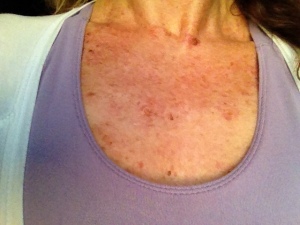
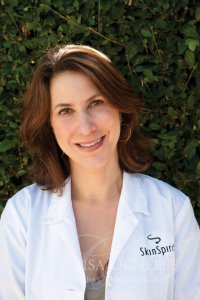
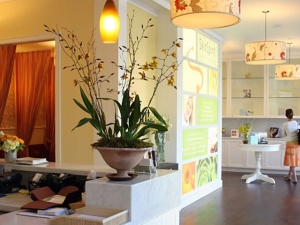
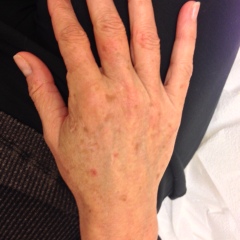
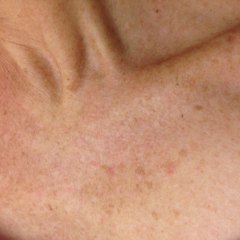
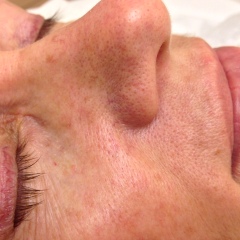
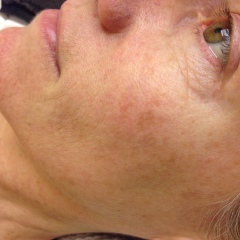
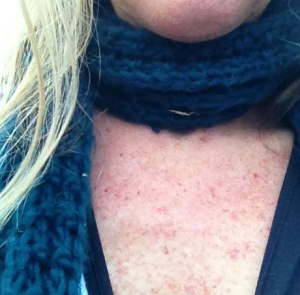
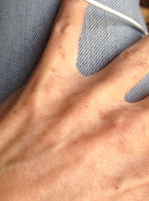
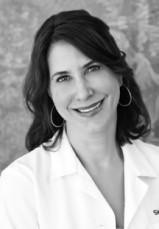
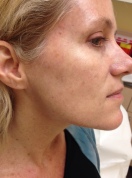
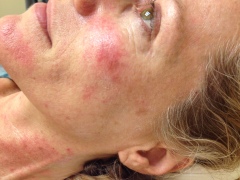
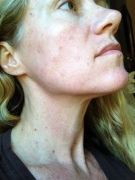
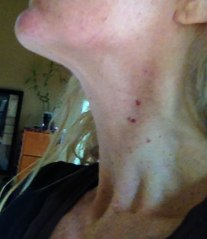
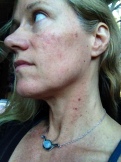
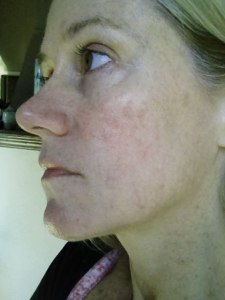
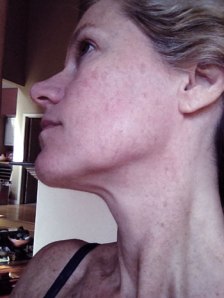


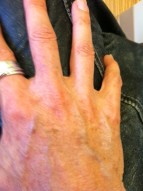
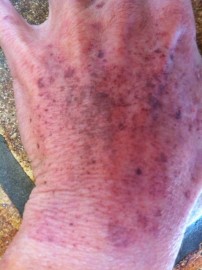









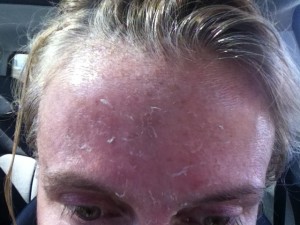












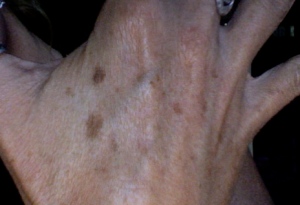






You must be logged in to post a comment.